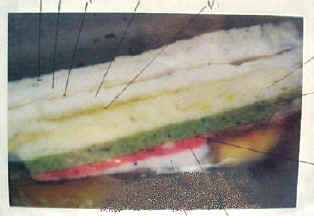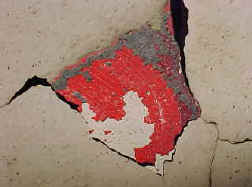October 1999
Painting Techniques and Materials
The murals were painted directly on the gray plaster exterior walls (Portland Cement). The wall surfaces were prepared with a glue sizing and white lead oil-priming layer prior to execution of the mural. The artwork was smoothly painted with an oil-like medium paint with no impasto except for the somewhat gritty texture of the wall surface beneath. Burnt sienna colored under drawings of the bold design forms are visible in areas where the upper layers of paint have weathered and flaked away. To develop the design, one to three coats of oil paint were employed. Upon completion, a natural resin varnish was then applied to the surface.
Condition:
 The somewhat impermeable, embrittled white lead ground layer exerts tension on the inherently weaker hygroscopic glue size layer. This has contributed to the weakened bond between the paint and ground layers from the wall leading to eventual paint loss. From the cross section analysis, it appears that some restorations were made to the murals prior to the first overpaint application. This finding substantiates early reports of attempts to consolidate insecurities in the mural soon after it was completed. The painting was subsequently overpainted entirely with an oil paint which is extremely cross-linked and difficult to remove. A synthetic resin type of coating was applied selectively to this first coating. One to three coats of latex overpaint was subsequently applied. Evidence of a clear synthetic resin coating was found to be applied between the multiple overpaint layers. Wolbers concludes that the tension exerted by the multiple layers of overpaint is resulting in shearing of the overpaint from the mural’s surface. (Click here for Wolbur’s report)
The somewhat impermeable, embrittled white lead ground layer exerts tension on the inherently weaker hygroscopic glue size layer. This has contributed to the weakened bond between the paint and ground layers from the wall leading to eventual paint loss. From the cross section analysis, it appears that some restorations were made to the murals prior to the first overpaint application. This finding substantiates early reports of attempts to consolidate insecurities in the mural soon after it was completed. The painting was subsequently overpainted entirely with an oil paint which is extremely cross-linked and difficult to remove. A synthetic resin type of coating was applied selectively to this first coating. One to three coats of latex overpaint was subsequently applied. Evidence of a clear synthetic resin coating was found to be applied between the multiple overpaint layers. Wolbers concludes that the tension exerted by the multiple layers of overpaint is resulting in shearing of the overpaint from the mural’s surface. (Click here for Wolbur’s report)
The majority of the surface of the murals lie under one to four layers of overpaint. Many areas are characterized by active cleavage, flaking paint, paint loss (both inter-layer and from the wall substrate), shearing overpaint and fading of exposed original paint.
While fading from prolonged exposure to intense sunlight and damaging ultra-violet light and heat is present, it is impossible to determine to what extent the artwork has been altered. Where original paint has been exposed, fading is evident and appears extreme. Where the original paint has been protected by overpaint, the colors are much more vibrant.
Not only has light caused damage, but also the exposure to harsh climatic conditions has taken its toll. On the murals with the most direct and prolonged exposure to sunlight, the layers of overpaint and the original paint layers have been unevenly and sporadically weathered away.
Condensation on the surface of the murals is another factor leading to deterioration. The Star report of 1996, noted “significant condensation on the mural surfaces on foggy, humid days”, both summer and winter”(4). This condition, on the unprotected damaged surfaces has undoubtedly resulted in active response by the Portland Cement, leading to delamination.
Peeling overpaint reveals original colors
This report was compiled referencing the following:
- 1986 Examination Reports by art conservators Linda Merk and Connie Silver
- 1996 Condition Report by conservator Staska Star
- 1997 Comprehensive Conservation Report by conservators Helen Houp and Greg Thomas, at the direction of Perry Huston of Perry Huston and Associates, Inc.
- 1997 Samples were analyzed by Richard Wolbers, Conservation Scientist at the University of Delaware, Winterthur, Delaware. Report is attached.
- 1999 On site evaluations and tests by Fine Art Conservator Scott M. Haskins of FACL, Inc.
 The examination involved a direct inspection of the entire surface of all of the murals to ascertain the security of the paint films and their condition. A mobile jack lift was employed to gain access to the mural surfaces. They were examined under normal light conditions and artificial light with magnification. On-site solvency tests were performed with a large variety of solvents and custom mixtures on over forty locations scattered across the murals under consideration in this contract. Forty microscopic samples were taken for cross-sectional analysis to ascertain the variations or similarities of the paint films after sixty years.
The examination involved a direct inspection of the entire surface of all of the murals to ascertain the security of the paint films and their condition. A mobile jack lift was employed to gain access to the mural surfaces. They were examined under normal light conditions and artificial light with magnification. On-site solvency tests were performed with a large variety of solvents and custom mixtures on over forty locations scattered across the murals under consideration in this contract. Forty microscopic samples were taken for cross-sectional analysis to ascertain the variations or similarities of the paint films after sixty years.
